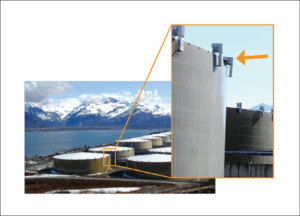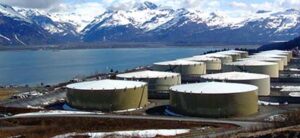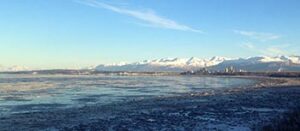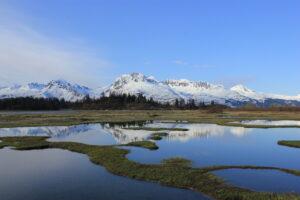A new Council report contains an estimate of crude oil vapors emitted during an incident at the Valdez Marine Terminal in 2022.
Damage from snow and ice during winter 2021-2022
Over the winter of 2021 to 2022, excessive snow and ice built up on top of the vast tanks that store crude oil at the terminal, damaging the pressure vacuum vents on many of the tanks. In some cases, the vents were completely sheared off. These vents control the internal tank pressures, preventing dangerous overpressure or vacuum conditions.

Pressure vacuum vents are located on the outside edge of the roof on each tank. (Larger image)
During normal tank operations, the internal tank pressure can vary. Oil levels inside the tanks increase or decrease, and other factors such as sunlight heating the tanks can affect the internal pressure.
When the tank vapor pressures get too high, the vents can open and release those vapors to the atmosphere. They also prevent too much oxygen from entering the tanks, which could lead to a fire or explosion.
Damage to the vents led to concerns about the release of crude oil vapors into the surrounding atmosphere and other dangers.
Evaluating the impact
In incidents like these, precise emission volumes are difficult to measure. However, estimates can be calculated using key data points. Last year, the Council hired Dr. Ron Sahu, a nationally respected expert in air quality and engineering, to do just that. By gaining a better understanding of the volume of emissions that was released, the Council hoped to better understand the potential effects on the environment of Port Valdez or nearby residents from this incident.
The Council provided Dr. Sahu with documents from Alyeska and data from the State of Alaska, acquired via public records requests. From these documents, he was able to determine key points such as:
- The number of tank vents that were damaged.
- The extent of damage to individual vents.
- The time period between when the damages were discovered until vent repairs were made and when pressure management of the tanks stopped.
- The amount of oil in each tank.
Dr Sahu also considered ambient conditions such as temperature, among other factors to complete his analysis.
Using special software developed by the U.S. Environmental Protection Agency that calculates air pollutant emissions from organic liquid storage tanks, Dr. Sahu conservatively estimated that between 79 to 193 tons of volatile organic compounds and hazardous air pollutants were released into the surrounding atmosphere from February through March 2022. Dr. Sahu emphasizes that his estimate is conservative, and that the total is likely higher. Among other factors, he only accounted for losses when the oil levels were not changing in the tanks.
He also provided input on Alyeska’s response to the incident, including areas to improve safety.
Alyeska disagrees with the estimate
Dr. Sahu used the best information that was available to the Council at the time of the report’s release. In preliminary feedback provided by Alyeska, they disagreed with the report’s calculations, noting that they believe the total emissions to be lower. The Council has requested additional information on what Alyeska believes to be inaccurate; however, Alyeska has so far declined to provide any more feedback, limiting the Council’s ability to address their concerns.
Read the report
The full report details Dr. Sahu’s calculations and how he arrived at his conclusions: Report on VOC Emissions from Snow Removal Incident at VMT in 2022


 The Council held several events in Valdez, April 30 – May 2, 2025, including the Council’s annual Board meeting and a public reception.
The Council held several events in Valdez, April 30 – May 2, 2025, including the Council’s annual Board meeting and a public reception.